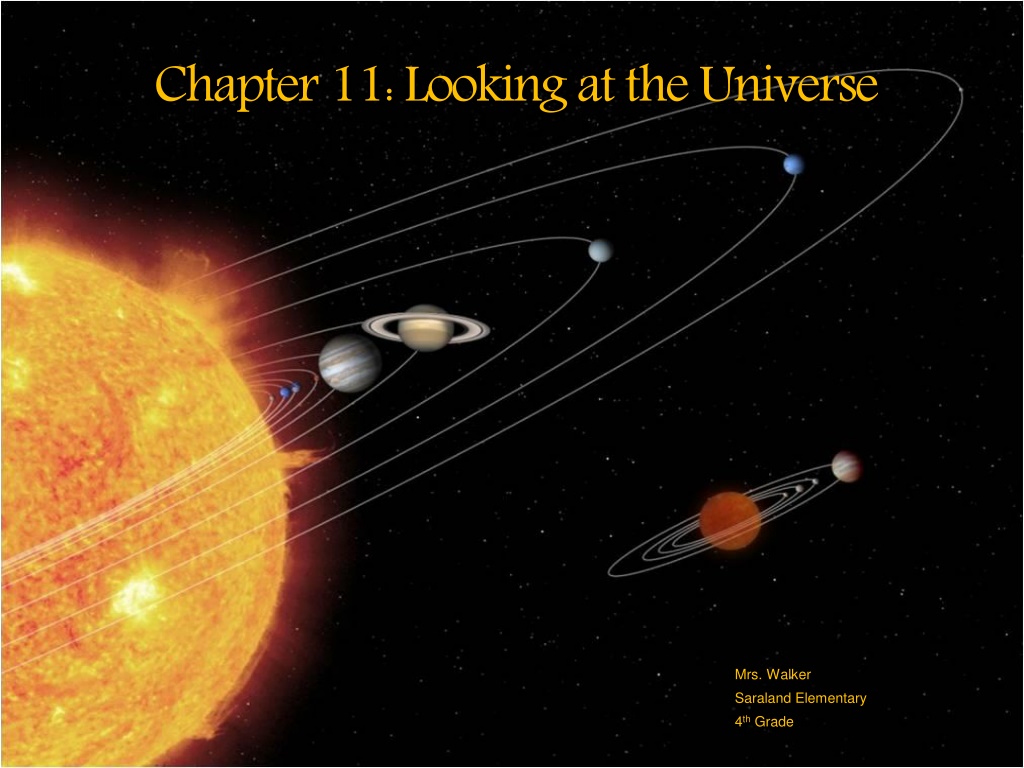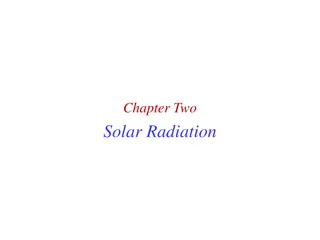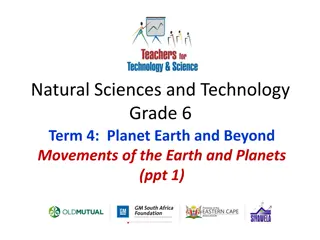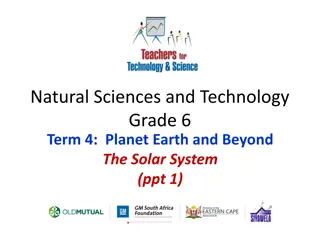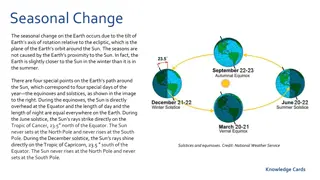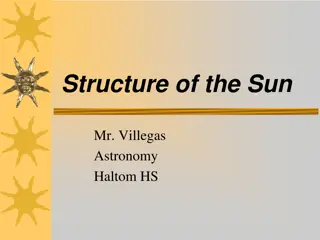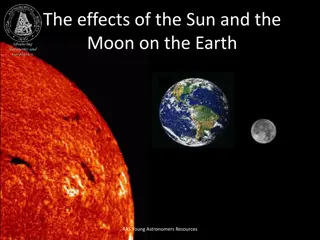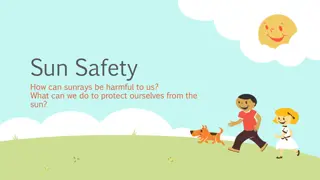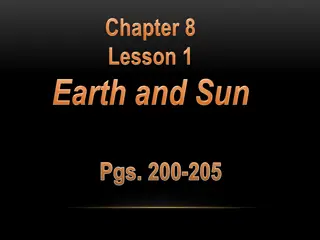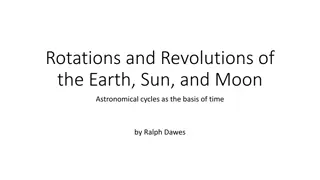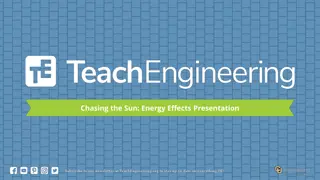Sun's Vital Role: Energy Source for Life on Earth
The Sun plays a crucial role in sustaining life on Earth by providing energy for warmth, growth, and various natural processes. Through the Sun's light and heat, life thrives on our planet, enabling the existence of plants, animals, and the intricate ecosystem. Explore the significance of the Sun's energy in shaping Earth's environment and supporting diverse life forms.
Download Presentation

Please find below an Image/Link to download the presentation.
The content on the website is provided AS IS for your information and personal use only. It may not be sold, licensed, or shared on other websites without obtaining consent from the author.If you encounter any issues during the download, it is possible that the publisher has removed the file from their server.
You are allowed to download the files provided on this website for personal or commercial use, subject to the condition that they are used lawfully. All files are the property of their respective owners.
The content on the website is provided AS IS for your information and personal use only. It may not be sold, licensed, or shared on other websites without obtaining consent from the author.
E N D
Presentation Transcript
Chapter 11: Looking at the Universe Mrs. Walker Saraland Elementary 4thGrade
Lesson 1: How is the Sun Important to Earth? Without the sun, Earth would be lifeless. Why? Turn and talk to your neighbor and discuss what life would be like on Earth if there was no sun. Why would it be lifeless? You have 1 minute to talk!
How is the Sun Important to Earth? Why It Matters Without the sun, Earth would be a lifeless, frozen rock. Light and heat from the Sun allow life to exist on Earth. The Sun warms the land, the oceans, and the atmosphere. Plants could not grow without energy from the Sun. In fact, the Sun is the source of almost all energy on Earth! Why It Matters
Earths Star Energy from the Sun If you stand outside on a hot sunny day, you can feel the warmth of sunlight on your skin. Energy from the Sun warms you and Earth s land and water. Land and water heats up at different rates. Water warms more slowly than sand and soil. This means that oceans, lakes, and other bodies of water warm more slowly than the land near them. Energy from the Sun
The Suns Effect on Earth Energy from the Sun heats Earth s water. Water heats up slowly, but it also cools more slowly than land. Plants use the Sun s energy to make food. Animals get this energy by eating plants or animals that eat plants. Some areas of Earth s surface are heated by the Sun s energy more than others. The uneven heating causes wind. The Sun s energy powers the water cycle. It causes water on Earth to evaporate, forming water vapor.
The Sun and Solar System The Sun is a star Like all stars, the Sun makes its own light. Earth and the moon do not make their own light. Moonlight is really light from the Sun that bounces off the Moon s surface. The Sun is at the center of the solar system. The solar system is made up of the Sun, nine planets, and other smaller bodies that orbit the Sun. There are many moons in the solar system, including Earth s moon.
The Sun and Solar System Earth is a planet, or large body made of rock or gas that moves around a star. Earth s path as it travels around the Sun is called its orbit. A moon is a body that moves in an orbit around a planet. Comparing the Sun, Earth, and Moon Diameter Diameter Mass Mass Surface Surface Body Body 1,393,000 km (864,950 mi) 333,000 times the mass of Earth Very hot gases on the Sun s surface are always in motion. Sun 12,756 km (7,918 mi) About 6 trillion Earth Earth s surface is covered mostly by water, rock, and soil. 3,475 km (2,160 mi) About 1/80 of the mass of Earth The surface of the Moon is dry and dusty. It has mountains and craters but no atmosphere. Moon
Gravity Have you heard someone say, What goes up must come down . No matter how high you can jump, you come back to Earth. What pulls you back? The answer is gravity. Gravity is the force that pulls bodies or objects toward other bodies or objects. Gravity keeps the planets orbiting the Sun. The Sun, the planets, and the Moon all have gravity. The mass of Earth is greater than the mass of the Moon. So Earth s gravity is stronger than the Moon s. You would weigh less on the Moon than you do on Earth. For example, someone who weighs 65 pounds on Earth weighs only 11 pounds on the Moon!!
Gravity http://studyjams.scholastic.com/studyjams /jams/science/solar-system/sgravity-and- inertia.htm
Review Questions 1. How does the Sun support life on Earth? 2. What is the solar system? 3. Why would an astronaut be able to lift heavy equipment more easily on the Moon than on Earth? 4. What is one way the size of Earth and the size of the Moon can be compared? 5. Make a list of the Sun s effects on Earth. Explain one of the effects and give an example of how it affects your daily life.
Review Questions 1. The Sun provides energy 2. The solar system is the Sun, the planets, and their moons. 3. Objects on the Moon weigh less than they do on Earth. 4. Earth is nearly four times larger than the Moon 5. The Sun heats Earth s land and water, causes wind, powers the water cycle, and provides plants and animals with energy. 6. D
Chapter 11 Lesson 2: The Outer Planets The five planets farthest from the Sun are called the outer planets.
Earths Neighbors Earth s and its neighbors, Mercury, Venus, and Mars, are the four planets closest to the Sun. They are called the inner planets. The inner planets are smaller than most of the other planets in the solar system. The inner planets all formed from dense rock. Although they are made od similar materials, they are not exactly alike. Earth has one moon revolving around it. Mars has two small moons. Neither Mercury nor Venus has a moon. Mercury Venus Mars inner planets. Mercury has many large and small craters. These craters are very old. There are plains between the craters Venus has highlands and rolling hills as Earth s land areas do. Venus also has lowlands much like Earth s ocean floors. Mars has a dusty, reddish surface and many volcanoes. Mars is the planet most like Earth.
Comparing Planets Inner and Outer Planets Planet Diameter Mass (Compared with Earth) Rings or Moons 4,879 km (3,032 miles) 0.06 of Earth s Mass Mercury None The five planets farthest from the Sun are called the outer planets. The outer planets are very different from the inner planets. Jupiter, Saturn, Uranus, and Neptune giants. The outer planets are the largest planets in the solar system and are made up mostly of gases. 12,104 km (7,521 miles) 0.82 of Earth s mass Venus None 12,756 km (7,926 miles) 1 Earth Earth 1 Moon 6,794 km ( 4,222 miles) Outer Planets 0.11 of Earth s mass Mars 2 Moons Jupiter, Saturn, Uranus, and Neptune are often called the gas giants. gas 142,980 km (88,846 miles) 318 Earths Jupiter Rings Many Moons 120,540 km (74,897 miles) 95 Earths Saturn Rings Many Moons 51,120 km (31,763 miles) 15 Earths Uranus Rings Many Moons 49,530 km (30,775 miles) 17 Earths Neptune Rings Many Moons 2,390 km (1,485 miles) less than 0.0005 Earths 1 Moon Pluto
Outer Planets Jupiter Jupiter Fun Facts About Jupiter: Four of Jupiter s moons can be seen through binocular s Average temperature:- 74C(-166F) A 65 lb. person would weigh about 154 lbs. on Jupiter. Fun Facts About Jupiter: Jupiter is the largest planet! It is so big that all the other planets would fit inside it! A huge storm in Jupiter s atmosphere, called the Great Red Spot of Earth. Jupiter rotates so quickly that one day is only 10 hours long! Jupiter s clouds change color daily. They move in bands in opposite directions. It has at least 63 moons. Great Red Spot, is more than twice the size
Outer Planets Saturn Saturn Fun Facts about Saturn Fun Facts about Saturn Saturn s rings are made of pieces of ice, dust, and rocks. Most pieces are only a few centimeters across. Saturn is the second largest planet. Like the other gas giants, it is covered by clouds. Saturn has many moons. Saturn is so light it could float in water A 65 lb. person would weigh about 69 lbs. on Saturn Astronomers have identified seven rings surrounding Saturn.
Outer Planets Uranus Uranus Fun Facts about Uranus Unlike the other planets, Uranus appears to rotate on its side. The average temperature is - 197 C ( -323 F) A person that weighs 65 lbs. on Earth would weigh about 59 lbs. on Uranus. Fun Facts about Uranus The third largest planet Methane, a gas in the planet s atmosphere, gives Uranus its beautiful blue-green color. Uranus was discovered in 1781 by William Herschel. Its rings are very faint and were not discovered until 1977. Uranus has many moons.
Outer Planets Neptune Neptune Fun Facts about Neptune Scientists named this planet after the Roman god of the sea, Neptune. Neptune has a magnetic field that is 25 times stronger than that of Earth. The average temperature is -200 C( -328 F) Fun Facts about Neptune Neptune is the fourth largest planet in the solar system. It is the smallest of the four gas giants. Neptune has fewer moons than the other gas giants. Winds can blow at 1,450 kilometers an hour! Neptune has huge storms. Some of the storms are as big as Earth.
Outer Planets Pluto Pluto Fun Facts about Pluto Fun Facts about Pluto It is the smallest planets in the solar system. Unlike the other gas giants, Pluto is rocky and icy. Once every 248 years, Pluto is inside Neptune s orbit. A person that weighs 65 lbs. on Earth weighs 4.3 lbs. on Pluto The average temperature is -215C ( -375 F) Pluto s discovery was a lucky accident.
BrainPop Watch Tim and Moby talk about the planets! Jupiter, Saturn, Uranus, Neptune, and Pluto https://www.brainpop.com/science/space/j upiter/preview.weml
